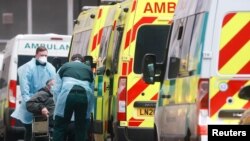Last April, European medical workers watched with rising horror as the health care system in parts of northern Italy buckled, overwhelmed by wave after wave of COVID-19-related patients.
Italy was the first European country to be struck full force by the coronavirus that causes the COVID-19 disease. Its struggle with the virus prepared most neighboring countries to weather the first wave of the pandemic without their hospitals and intensive care units (ICUs) becoming strained to the breaking point, thanks largely to the imposition of lockdowns and travel bans.
But now, hospitals across much of Europe are struggling to cope with the influx of seriously ill patients.
“The bed and ICU occupancy rates are still increasing or remain high in many countries, and further increases may challenge health care capacity,” warned the European Center for Disease Prevention and Control, a European Union agency, in its latest risk assessment.
With tough new pandemic restrictions, some countries have been able to stabilize the numbers of the newly infected, giving their hospitals some relief; however, officials in several health care systems are raising the alarm, notably in northern regions of Italy and Greece.
French health care officials acknowledge that their system came close to breaking in mid-November. They say the situation has stabilized, but in parts of rural France, including the Auvergne-Rhône-Alpes region, ICU occupancy is at an alarming 90%.
The Swedish government — which in 2020 opted not to lock down during Europe's first waves of the pandemic — moved to impose restrictions before Christmas after health officials reported that 99% of ICU beds in Stockholm were full.
The big unknown for many European countries is how they will fare once they are hit with the more easily transmissible mutant coronavirus strain that British authorities flagged last month.
The mutant strain has now been identified in at least 33 countries. Scientists are trying to establish why this strain, now fast becoming the dominant one in Britain, is so easy to transmit; but they agree it is boosting the numbers of people being infected, putting extra strain on hospitals and Britain’s ambulance service.
Medical officials across the continent say that Britain, rather than Italy, is the new test country in how it handles the virus, and they are observing anxiously how British hospitals cope.
The signs are not good.
Hospitals overwhelmed
Britain’s National Health Service (NHS) is overloaded and in a perilous state with the deluge of patients straining hospital staff and resources.
Because of the strain, Prime Minister Boris Johnson announced Monday he was ratcheting up pandemic restrictions to the highest level possible, locking down the country. Johnson previously resisted imposing another total national lockdown, the third since the pandemic emerged.
Hours earlier in Scotland, First Minister Nicola Sturgeon announced the need for decisive action, also placing Scotland under a full lockdown.
“We are now seeing a steeply rising trend of infections,” Sturgeon said. “It is no exaggeration to say that I am more concerned about the situation we face now than I have been at any time since March last year.”
In a stark warning beforehand, Britain’s chief medical officers said they were “not confident that the NHS can handle a further sustained rise in cases, and without further action, there is a material risk of the NHS in several areas being overwhelmed over the next 21 days.”
Some doctors and nurses say a lockdown should have been called earlier, saying parts of the NHS, especially in London and the southeast, have been overwhelmed for days with the number of coronavirus patients at record highs.
The number of people being treated in hospitals in Britain stood at 26,626 Monday — a week-on-week increase of 30%. Eastern England saw a jump in hospital admissions of 44%, according to Public Health England, the agency that oversees the NHS.
Independent members of the government’s main scientific advisory panel have been warning for days that infections in Britain are “truly out of control,” pointing to London's COVID-19 positivity rate, which is now at 25%. The World Health Organization says infections are out of control when the positivity rate goes above 5%.
For the first time in the NHS’s 70-year history, hospitals in London and the southeast are being paired with hospitals elsewhere, mainly in western Britain, allowing for the hardest-hit regions to transfer patients to areas that have some ICU capacity to spare.
Several hospitals reported last week that they had reached capacity, despite having added more beds. Fourteen ICUs in the south were at least 95% full throughout Christmas week, half a dozen of them in London. Mechanical ventilators are also in short supply at some hard-pressed hospitals.
Last week, managers at the Royal London Hospital in Whitechapel, a major teaching hospital, told staff the hospital was in “disaster mode,” adding, “We are no longer providing high standard critical care, because we cannot.”
Like north Italy when it was first hit by the virus last year, London consultants say they are being forced to withhold full treatment to some coronavirus patients in favor of those who have the best chance of surviving.
Paramedics are reporting they are treating patients in ambulances for hours at a time because no hospital beds are available. Many hospital managers have ordered staff not to speak to the media unless they have prior clearance. Unlike last year, television crews are finding it hard to get permission to film wards.
Dr. Megan Smith, an anesthetist at Guy’s and St. Thomas’ Hospital, told British broadcasters that medics had to make “horrifying” decisions about the competition for ventilators. The hospital is where the British prime minister was treated last year for COVID-19.
“It’s not a position any of us ever want to be in, and we’re used to making difficult decisions as doctors. But deciding the outcome of, effectively, a competition for a ventilator, is just not what anyone signed up for,” Smith told Britain’s ITN network. “We shouldn’t be having to do it, but we are.”












